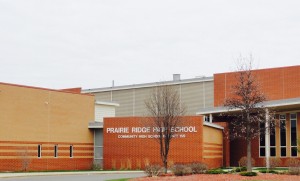Prairie Ridge teacher’s methods really compute
Adela Crandell Durkee — April 21, 2015Brian Burger may be best known for staying out of the way. He’s the Prairie Ridge High School teacher who mentored three students who created “Snow Day Calculator,” in 2014.
The app hit GooglePlay’s top downloaded apps and the students enjoyed a flash of celebrity treatment. Calvin Breseman, Tanishq Dubey, and Gustavo Farias gave kudos to Burger for inspiring their joint effort.
Burger deflects the credit back to the boys as he quietly continued to inspire students’ interest in computer programming.
Getting out of the way is an essential component of Burger’s method of teaching.
His classes, Introductory Computer Programming and AP Computer Programming, are outside of the Common Core Curriculum. Instead, Burger follows the Prairie Ridge Next Generation Science standards.
Student performance expectations include a student’s ability to apply a practice to knowledge gained. Success in Burger’s classes relies on understanding and application, as opposed to just memorizing facts. NGSS goes on to emphasize that:
“… learning about science and engineering involves integration of the knowledge of scientific explanations (i.e., content knowledge) and the practices needed to engage in scientific inquiry and engineering design. Thus the framework seeks to illustrate how knowledge and practice must be intertwined in designing learning.”
As a child, Burger tinkered around with computers and learned to fix them as a hobby. “I like computers. If I could, I’d teach computer science all day long,” said Burger.
His own self-guided learning process dovetails with the NGSS’s teaching goals. In the past, students learned a series of disjointed facts. NGSS focuses on a progression of knowledge leading to overall understanding of science and its application. Rather than learning disconnected and even contradictory bits of knowledge as isolated facts, NCGG helps students learn core principles and theories and use them to make sense of new information or tackle novel problems.
Burger began his career at Prairie Ridge teaching Earth Science and Chemistry. He got a computer science endorsement in 2006. Burger’s classes are part of Prairie Ridge’s Stem Program. He uses the inquiry-based learning. In other words, Burger teaches the curriculum by first showing a feature and then letting students figure out how to implement programming to make it happen. In a recent lesson, Burger showed them a program with an object in a box. The students figured out how to make object jump onto box. Students define the problem, solve it, and then explain the process.
According to the “Snow Day Calculator” developers, defining the problem can take weeks and is key to success. Student performance expectations include a student’s ability to apply a practice to content knowledge.
Besides learning to program and create apps, Burger explains that the process serves the students by teaching them to think in a different ways. “They must think analytically and creatively to solve a problem.” After that, “the students must put together a step by step process to achieve a goal.” For Burger, that means the class is relevant to the students’ experiences.
The AP class will complete testing to the NGSS requirement in May. Those students who pass the standards are eligible for college credit. After the test, the app development begins. Burger teaches a simple programming class. What the app does is up to the students. They develop the inputs, algorithms and outputs and create an Android app. Sometimes, as was the case with the “Snow Day Calculator,” the student-developers, get so inspired they continue long after the class is officially over.
Calvin Breseman, Tanishq Dubey, and Gustavo Farias took Burger’s AP class in 2012. They spent a lot of time outside of and after class, checking in with Burger for advice and guidance. The students turned in their first prototype as part of their class, but it was 2013 before the app was released as a free Android download. Burger continued to support the students’ endeavor throughout the process, offering comments and advice and getting out of the way of the students’ success.




